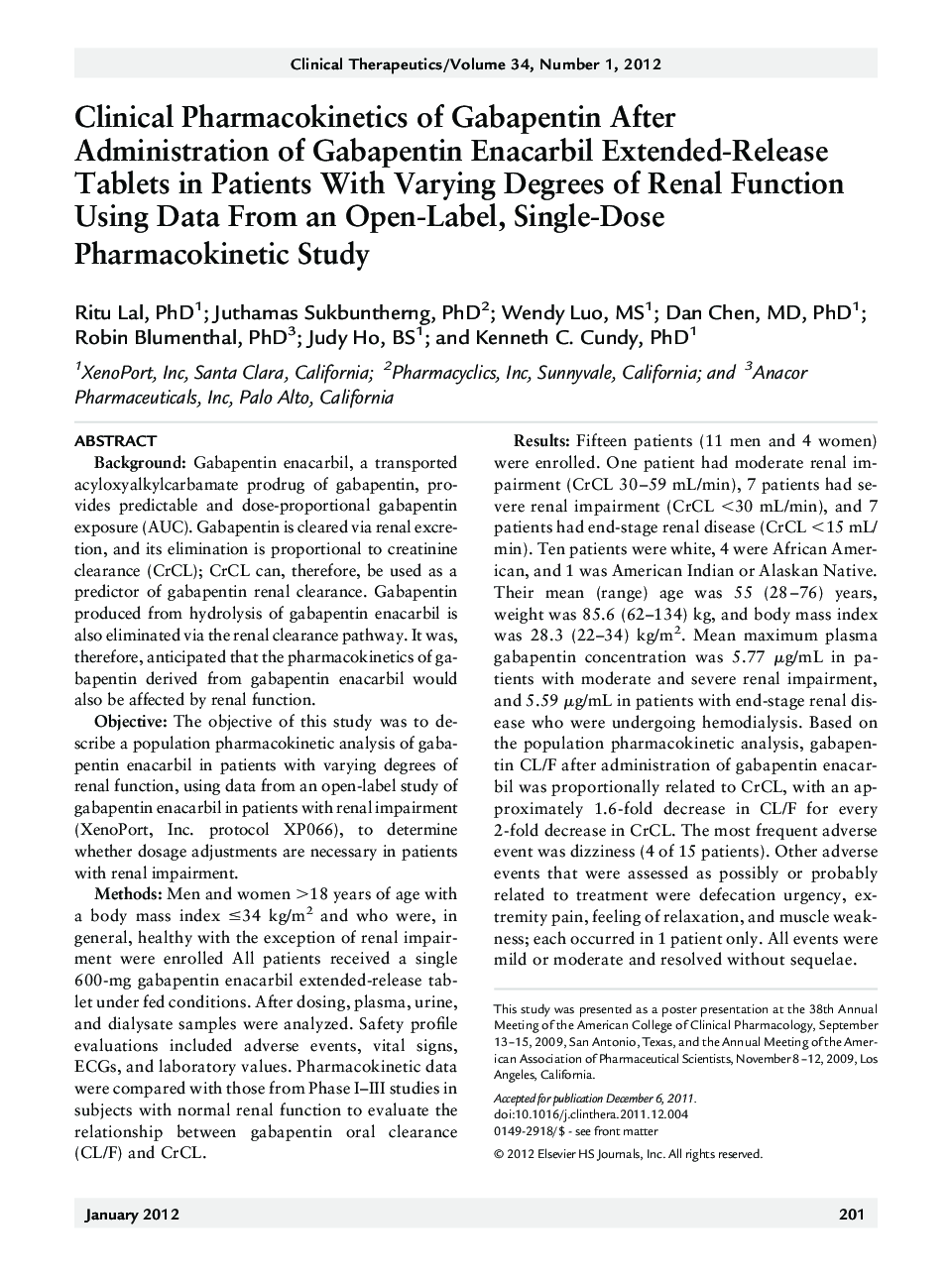| کد مقاله | کد نشریه | سال انتشار | مقاله انگلیسی | نسخه تمام متن |
|---|---|---|---|---|
| 2527382 | 1119912 | 2012 | 13 صفحه PDF | دانلود رایگان |

BackgroundGabapentin enacarbil, a transported acyloxyalkylcarbamate prodrug of gabapentin, provides predictable and dose-proportional gabapentin exposure (AUC). Gabapentin is cleared via renal excretion, and its elimination is proportional to creatinine clearance (CrCL); CrCL can, therefore, be used as a predictor of gabapentin renal clearance. Gabapentin produced from hydrolysis of gabapentin enacarbil is also eliminated via the renal clearance pathway. It was, therefore, anticipated that the pharmacokinetics of gabapentin derived from gabapentin enacarbil would also be affected by renal function.ObjectiveThe objective of this study was to describe a population pharmacokinetic analysis of gabapentin enacarbil in patients with varying degrees of renal function, using data from an open-label study of gabapentin enacarbil in patients with renal impairment (XenoPort, Inc. protocol XP066), to determine whether dosage adjustments are necessary in patients with renal impairment.MethodsMen and women >18 years of age with a body mass index ≤34 kg/m2 and who were, in general, healthy with the exception of renal impairment were enrolled All patients received a single 600-mg gabapentin enacarbil extended-release tablet under fed conditions. After dosing, plasma, urine, and dialysate samples were analyzed. Safety profile evaluations included adverse events, vital signs, ECGs, and laboratory values. Pharmacokinetic data were compared with those from Phase I–III studies in subjects with normal renal function to evaluate the relationship between gabapentin oral clearance (CL/F) and CrCL.ResultsFifteen patients (11 men and 4 women) were enrolled. One patient had moderate renal impairment (CrCL 30–59 mL/min), 7 patients had severe renal impairment (CrCL <30 mL/min), and 7 patients had end-stage renal disease (CrCL <15 mL/min). Ten patients were white, 4 were African American, and 1 was American Indian or Alaskan Native. Their mean (range) age was 55 (28–76) years, weight was 85.6 (62–134) kg, and body mass index was 28.3 (22–34) kg/m2. Mean maximum plasma gabapentin concentration was 5.77 μg/mL in patients with moderate and severe renal impairment, and 5.59 μg/mL in patients with end-stage renal disease who were undergoing hemodialysis. Based on the population pharmacokinetic analysis, gabapentin CL/F after administration of gabapentin enacarbil was proportionally related to CrCL, with an approximately 1.6-fold decrease in CL/F for every 2-fold decrease in CrCL. The most frequent adverse event was dizziness (4 of 15 patients). Other adverse events that were assessed as possibly or probably related to treatment were defecation urgency, extremity pain, feeling of relaxation, and muscle weakness; each occurred in 1 patient only. All events were mild or moderate and resolved without sequelae.ConclusionsThe data suggest that dosage adjustment for gabapentin enacarbil is necessary in patients with impaired renal function. Gabapentin enacarbil, 600 mg, seemed to be well tolerated in this small selected population.
Journal: Clinical Therapeutics - Volume 34, Issue 1, January 2012, Pages 201–213